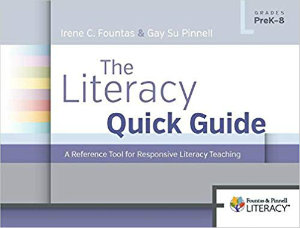Quick Reference Guide to Literacy Teaching
The Literacy Quick Guide: A Reference Tool for Responsive Literacy Teaching
By Irene C. Fountas and Gay Su Pinnell
(Heinemann, 2018 – Learn more)

The Literacy Quick Guide is just as the title describes. It is a quick reference for “all things literacy” in your Pre-K to 8th grade classes. There are 83 glossy cardboard pages of information about using responsive literacy teaching in the classroom.
The Literacy Quick Guide is divided into tabbed sections including Introduction, A Design for Responsive Literacy Teaching, Reading, Reader’s Workshop, Talking About Reading, Writing About Reading, Writing, Writer’s Workshop, Phonics, Spelling and Word Study, and Professional Resources. These tabbed sections make it extremely easy to find information to support literacy tasks in the classroom.

Designing literacy instruction
The first section, A Design for Literacy Instruction, explains how to use whole-group and small group teaching as well as individual teaching to meet the literacy needs of the learners in your classroom. It lays out the systems of strategic actions for readers as well as a processing system for writing.
This section contains a lot of information about designing a literacy rich classroom as well as explaining the critical connections between reading and writing.
A Design for Literacy Instruction also gives advice for using text sets in the classroom, for setting up a classroom library, and for using leveled books as a flexible tool for the teacher to incorporate in lesson planning and for supporting readers to make good text choices. No labels here.
Reading
The Reading Section describes Interactive Read-Alouds, Shared Reading, Guided Reading, Independent Reading and Book Clubs, and how each of these components relates to teacher support and student independence. Each topic has a brief summary including information on what it is, why it is important, and what it looks like in the classroom. There’s also help to plan for using each component during instruction and to assess student progress.
The Reader’s Workshop section describes using Book Talks, Mini Lessons and Group Share for whole group instruction. It breaks down each component and provides ideas for anchor charts and ways to develop a community of readers. Talking About Reading explains using Turn and Talk, Conferring and Discussion in Book Clubs. The different roles of the teacher are described based on the level of support needed for facilitating discussion.
Writing About Reading describes using writing as a “tool for reflection” rather than as a test of what students know. There are recommendations for drawing about reading and responding to the different purposes of functional writing, narrative writing, informational writing, persuasive writing and poetic response. This section contains sidebar information on teaching effective note-taking, writing to prompts, and learning to create effective reports. There is also information on creating a Reader’s Notebook to use as a dialogue about reading between student and teacher.
Writing
The Writing Section describes Modeled/Shared Writing, Interactive Writing, Guided Writing and Independent Writing, and how each of these components relates to teacher support and student independence. Each topic has a brief summary including information on what it is and why it is important. One of the graphics included in this section lays out the structure of teaching guided writing lessons in small groups.
The Writer’s Workshop section describes using Mini Lessons, Mentor Texts and Group Share for writing instruction. There is a chart describing the types of writing mini-lessons that should be presented including Management, the Writing Process, Genre, Craft and Conventions.
One word at a time
The final section of the book is Phonics, Spelling and Word Study. There are descriptions and examples for nine areas of learning, including Early Literacy Concepts, Phonological Awareness, Letter Knowledge, Letter-Sound Relationships, Spelling Patterns, High-Frequency Words, Word Meaning/Vocabulary, Word Structure and Word-Solving Actions. It also includes sections for Systematic Phonics and Word Study Teaching as well as information on Lesson Design.
Overall, this guide would be useful while making decisions about designing classroom literacy routines. The information is brief and easy to locate within the text. It does not include a lot of in-depth research and reasoning (although it’s clear the authors know these things). It’s really intended as a more accessible resource for locating summarized information.
For the teacher who wants more background and information about these practices, there are references to another Fountas and Pinnell book, Literacy Continuum, that readers will find throughout this quick guide, citing recommended pages for developing a deeper understanding.
This is a good resource for quick planning decisions for the busy teacher who does not have much time to read lengthy explanations and theory while racing to ready a lesson.
Stacy Thorpe teaches Special Education in Gobles, Michigan. She recently completed her Master’s degree in Learning Disabilities at Spring Arbor University. Stacy is always trying to find new ways to help ALL students grow and learn. When she is not teaching or researching, Stacy is spending time with her husband and three sons: cheering them on in sporting events, enjoying their musical performances, supporting their involvement on Solar Car and Robotics Teams, and enjoying family campouts.



































